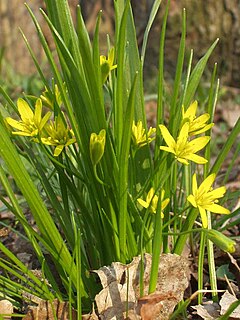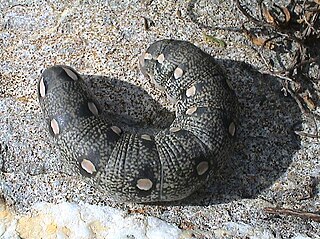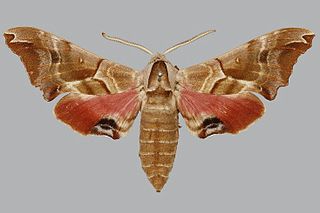
Gagea is a large genus of spring flowers in the lily family. It is found primarily in Eurasia with a few species extending into North Africa and North America.

Leymus is a genus of plants in the grass family Poaceae (Gramineae). It is widespread across Europe, Asia, and the Americas.

Ephedra is a genus of gymnosperm shrubs, the only genus in its family, Ephedraceae, and order, Ephedrales. The various species of Ephedra are widespread in many lands, native to southwestern North America, southern Europe, northern Africa, southwest and central Asia, northern China and western South America.

Leonurus is a genus of flowering plants in the family Lamiaceae. It is native to Europe and Asia, naturalized in New Zealand, Hawaii, New Caledonia, and much of North and South America.

Galium uliginosum or fen bedstraw is a plant species of the genus Galium. It is widespread across most of Europe as well as Morocco, Western Siberia, Turkey, Kazakhstan and Xinjiang. It is reportedly naturalized in New Zealand, Greenland and the Crozet Islands.

Siona lineata, the black-veined moth, is a moth of the family Geometridae. The species was first described by Giovanni Antonio Scopoli in his 1763 Entomologia Carniolica.

Agapeta hamana is a moth of the family Tortricidae. It is found in Europe, western and southern Siberia, the Caucasus, Kazakhstan, Transcaucasia, Asia Minor, Central Asia, Iran, Afghanistan, Mongolia, western China and northern India.

Phragmatobia fuliginosa, the ruby tiger, is a moth of the family Erebidae.
Manulea palliatella is a moth of the family Erebidae. It is found in Southern, Central and Eastern Europe, Asia Minor, Iran, Afghanistan, Central Asia, Kazakhstan.

Chelis maculosa is a tiger moth of the family Erebidae. It is found in Southern and Central Europe up to Hungary, in eastern direction it occurs through Ukraine, Southern Russia, Kazakhstan to north-western regions of Chinese Xinjiang.

Galium trifidum is a species of flowering plant in the coffee family, known by the common name three-petal bedstraw. It grows widespread in the arctic, temperate and subtropical regions of the Northern Hemisphere: northern and central Asia, northern and eastern Europe and much of North America.

The Flax Bollworm is a species of moth of the Noctuidae family. It is found in China, Kazakhstan, central Asia, northern Mongolia (Khangai), the Russian Far East, the Korean Peninsula, southern European part of Russia, southern and central Europe, southern and eastern Siberia and Turkey. In North America it is found from south-central Manitoba west to British Columbia, north to the Northwest Territories and Yukon and Alaska and south to Colorado.

Hyles vespertilio is a moth of the family Sphingidae.

Rethera komarovi, the madder hawkmoth, is a moth of the family Sphingidae. The species was first described by Otto Vasilievich Bremer and William Grey in 1853. It is found in south-western Europe, Asia Minor, Afghanistan, Turkestan, Iran and Iraq.

Acleris hastiana is a moth of the family Tortricidae. It is found in Europe, northern Iran, Kazakhstan, Ala Tau, central Siberia, Irkutsk, the Amur region and China. In North America it is found from the north-eastern United States across southern Canada to British Columbia and south along the Pacific Coast to California.

Smerinthus kindermannii, the southern eyed hawkmoth, is a species of moth of the family Sphingidae. It is found throughout the central Palaearctic Region, from Turkey, Cyprus and Lebanon, east through Iraq, Iran, Afghanistan and northern Pakistan to Kashmir. From there, north and north-east through Turkmenistan, Uzbekistan, Tajikistan, Kyrgyzstan and Kazakhstan, to north-western China. It has also been reported from Israel and Kuwait.

Sphingonaepiopsis gorgoniades, the Gorgon hawkmoth, is a moth of the family Sphingidae. The species was first described by Jacob Hübner in 1819. It is found from Croatia, Albania, Macedonia, central and southern Greece, eastern Bulgaria and Romania across southern Ukraine and the Crimea, southern Russia as far north as Kazan, the southern Urals and eastern Kazakhstan to Kyrgyzstan and Afghanistan. It has also been recorded from central and southern Turkey, Lebanon, Israel and western Jordan eastward across northern Iraq, the Caucasus, northern Iran to southern Turkmenistan.

Lacydes spectabilis is a moth of the family Erebidae. It was described by Tauscher in 1806. It is found in south-eastern Ukraine, eastern European Russia, western Siberia, Kazakhstan, Central Asia, Armenia, eastern Turkey, Turkmenistan, Afghanistan, China (Xinjiang) and southern Mongolia.

Gnaphosa is a genus of ground spiders that was first described by Pierre André Latreille in 1804. They all have a serrated keel on the retromargin of each chelicera.
Galium rubioides is a species of plants in the family Rubiaceae, native to Europe and Asia. Natural distribution is from Austria and Croatia east to Russia and Turkey, plus the Caucasus, Western Siberia, Kazakhstan, northern China and the Amur region of Russia. The species is also reportedly naturalized in Northampton County, Pennsylvania.

























